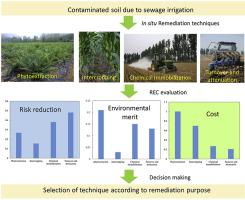Environmental Pollution ( IF 7.6 ) Pub Date : 2020-07-09 , DOI: 10.1016/j.envpol.2020.115193 Xiaoming Wan 1 , Mei Lei 1 , Jun Yang 1 , Tongbin Chen 1

|
The traditional assessment of agricultural soil remediation technologies pay limited attention to sustainability and only considers the decrease in contaminant concentrations and cost, even though the sustainability of these technologies has been prioritized. This 3-year field study comprehensively assessed the sustainability of four commonly used agricultural soil remediation technologies in terms of metal(loid) removal efficiency, environmental merit, and cost. The farmland was contaminated by previous sewage irrigation with excessive amounts of As, Cd, and Pb. The four selected remediation technologies used were phytoextraction, intercropping of hyperaccumulators and cash crops, chemical immobilization, and turnover and attenuation (T&A). A risk reduction–environmental merit–cost model was utilized to compare these four technologies. Results showed that T&A reduced the health risks posed by excess metal(loid)s by ∼47% and yielded the highest risk reduction and lowest cost. Phytoextraction achieved the highest environmental merit because it produced the least interruption to the environment. A simplified assessment frame for soil remediation technology was established from a retrospective aspect using data from a real soil remediation project. Environmental merit is a less considered factor and more difficult to quantify than risk reduction or cost, thus requiring increased attention.
中文翻译:

为期三年的野外试验,针对四种被金属(胶体)污染的土壤进行原位修复技术的风险降低,环境价值和成本评估。
对农业土壤修复技术的传统评估很少关注可持续性,即使这些技术的可持续性已被优先考虑,但仅考虑污染物浓度和成本的降低。这项为期三年的野外研究从金属(金属)去除效率,环境价值和成本方面全面评估了四种常用的农业土壤修复技术的可持续性。农田被先前的污水灌溉所污染,其中砷,镉和铅的含量超标。使用的四种选定的修复技术是植物提取,超级蓄积剂和经济作物间作,化学固定化以及周转和衰减(T&A)。利用降低风险-环境价值-成本模型来比较这四种技术。结果表明,T&A将过量金属(金属)带来的健康风险降低了约47%,并且降低风险最高,成本最低。植物提取获得了最高的环境价值,因为它对环境的干扰最少。使用真实土壤修复项目的数据,从回顾性角度建立了土壤修复技术的简化评估框架。与降低风险或降低成本相比,环境价值是考虑较少的因素,并且更难以量化,因此需要更多的关注。使用真实土壤修复项目的数据,从回顾性角度建立了土壤修复技术的简化评估框架。与降低风险或降低成本相比,环境价值是考虑较少的因素,并且更难以量化,因此需要更多的关注。使用真实土壤修复项目的数据,从回顾性角度建立了土壤修复技术的简化评估框架。与降低风险或降低成本相比,环境价值是考虑较少的因素,并且更难以量化,因此需要更多的关注。











































 京公网安备 11010802027423号
京公网安备 11010802027423号